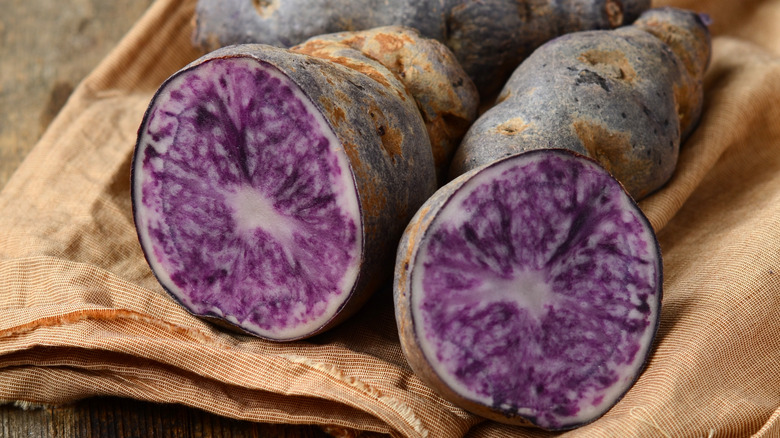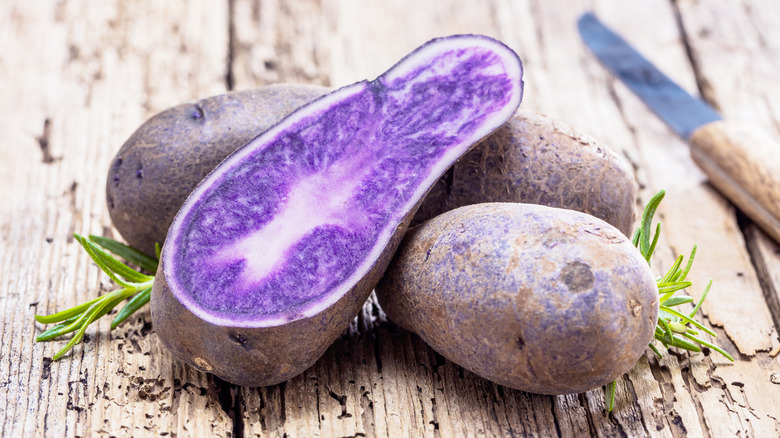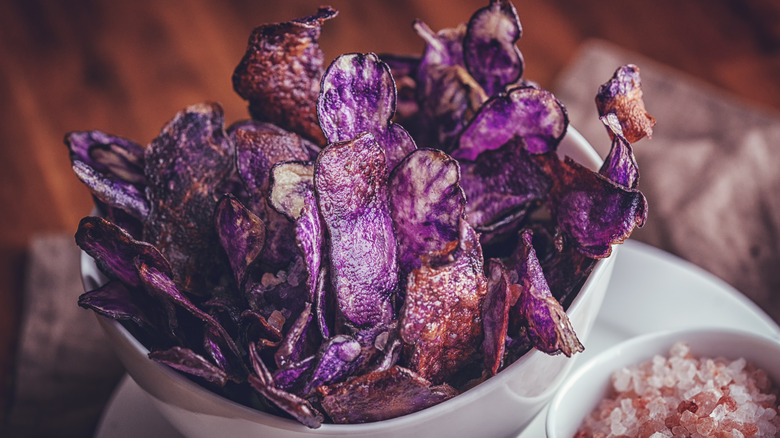What Are Vitelotte Potatoes And How Are They Best Used?
If you think potatoes are boring, think again. With over 200 varieties across seven categories, even the biggest skeptic is sure to find a unique potato that will wow their senses and their stomach. One of those most likely to do so is the Vitelotte potato, a tuber with an unusual taste and eye-catching hue.
The Vitelotte potato (Solanum tuberosum) originated in Peru over 800 years ago, but its introduction to France in the 1800s resulted in it being most widely known in modern times for its popularity in French cuisine. It falls under the category of purple and blue potatoes, as the skin has a startling, deep indigo color while its flesh is violet with patches of white. This appearance has led to it sometimes being called the Vitelotte noir (black Vitelotte) or Chinese truffle. The potato's coloration is due to it containing high amounts of anthocyanin, which is regarded as a powerful antioxidant.
What do Vitelotte potatoes taste like?
In addition to their unusual appearance, these potatoes are also distinct from better-known tubers thanks to their unique flavor and smell. Strange as it may seem, Vitelotte potatoes are largely said to possess an aroma and taste somewhat similar to roasted chestnuts. As such, their flavor can be summarized as nutty, buttery, and slightly sweet.
The texture of these potatoes is comparable to that of other starchy, floury varieties like Russet and Idaho potatoes. This means that while they have dense flesh while raw, they become dry, crumbly, and even a little bit mealy upon being cooked. They tend to have thicker skin than many other potatoes, which can make them extremely frustrating to peel. To save yourself some stress, it is better to wait to remove the skin until after these potatoes have been cooked, as the skin will have softened a bit.
How to cook with Vitelotte potatoes
As an ingredient primarily used in Western Europe, most traditional recipes using the Vitelotte potato come from that region, most often from France or the U.K. Common Western European dishes for this potato include bangers and mash, au gratin potatoes, potato galettes, and chips (also known as french fries in America). They are also included in soups and other purees to add an exciting splash of color.
With some creativity and understanding of the Vitelotte potato's properties, however, you can create delicious meals that go beyond the traditional fare. The starchy quality of this potato means it lends itself particularly well to being fried, since high starch results in an extra crispy exterior. This makes it a great option for making things like chips (the American kind, in this case) and potato pancakes. Its floury texture means it also delivers great results when used in potato-based doughs, such as the kind that is used for making gnocchi.
Where to buy Vitelotte potatoes
Unless you live in one of the areas where Vitelotte potatoes are popular, they can be quite hard to find. They may be sold in some specialty grocery shops, especially those that focus on French foods and produce. You can identify the Vitelotte potato not only by its dark purple color but also by its shape, as it is somewhat small and has many lumpy ridges along its length. If searching for them in person does not yield any results, they can also be ordered online through gourmet suppliers like The Artisan Food Company.
Once you have your hands on some of these potatoes, you will want to take care to store them properly. Similar to other potatoes, these do best in a cool, dry, and dark space like a pantry or a basement. Under the right conditions, Vitelotte potatoes will last up to three weeks.



